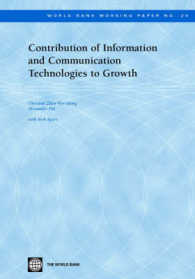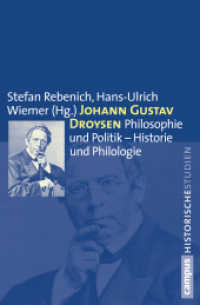基本説明
The present volume focuses on two tasks: The first deals with the discussion of functional principles related to relative clause formation: diachrony and paths of grammaticalization, simplicity vs. complexity, and formalization of rules to capture semantic-syntactic correlations. The second provides a typological overview of relative clauses in nine different languages going from north to south in the Americas.
Full Description
Patterns of relative clause formation tend to vary according to the typological properties of a language. Highly polysynthetic languages tend to have fully nominalized relative clauses and no relative pronouns, while other typologically diverse languages tend to have relative clauses which are similar to main or independent clauses. Languages of the Americas, with their rich genetic diversity, have all been under the influence of European languages, whether Spanish, English or Portuguese, a situation that may be expected to have influenced their grammatical patterns. The present volume focuses on two tasks: The first deals with the discussion of functional principles related to relative clause formation: diachrony and paths of grammaticalization, simplicity vs. complexity, and formalization of rules to capture semantic-syntactic correlations. The second provides a typological overview of relative clauses in nine different languages going from north to south in the Americas.
Contents
1. map; 2. Introduction (by Comrie, Bernard); 3. part i. Diachrony, typology, and theory; 4. Toward a diachronic typology of relative clause (by Givon, T.); 5. The evolution of language and elaborateness of grammar: The case of relative clauses in creole languages (by Kuteva, Tania); 6. Some issues in the linking between syntax and semantics in relative clauses (by Van Valin Jr., Robert D.); 7. Part II. Uto-Aztecan; 8. Relative clauses and nominalizations in Yaqui (by Gonzalez, Albert Alvarez); 9. On relative clauses and related constructions in Yaqui (by Guerrero, Lilian); 10. From demonstrative to relative marker to clause linker: Relative clause formation in Pima Bajo (by Estrada-Fernandez, Zarina); 11. Functional underpinnings of diachrony in relative clause formation: The nominalization-relativization connection in Northern Paiute (by Thornes, Tim); 12. Part III. Elsewhere in the Americas; 13. Clauses as noun modifiers in Toba (Guaycuruan) (by Carpio, Maria Belen); 14. Between headed and headless relative clauses (by Epps, Patience); 15. Relative clauses in Seri (by Marlett, Stephen A.); 16. Relative clauses in Gaviao of Rondonia (by Moore, Denny); 17. Relative clauses in Yucatec Maya: Light heads vs. Null domain (by Gutierrez-Bravo, Rodrigo); 18. Questionable relatives (by Mithun, Marianne); 19. Language and language family index; 20. Name index; 21. Subject index








